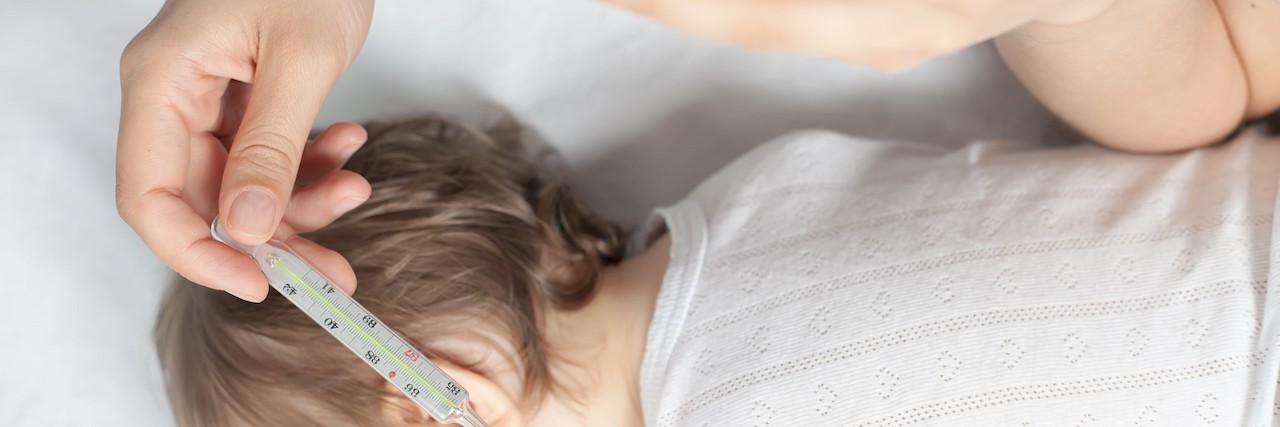Why My Son's PFAPA Diagnosis Is 'Not Just a Fever'

The thermometer beeped as my husband and I waited in sickened anticipation. Beep beep. Two beeps are bad. Two beeps mean his temperature is above 101. We looked together… 104. Panic. What do we do?
This was our third month in a row with periodic fever, aphthous stomatitis, pharyngitis, cervical adenitis (PFAPA). It was our first Thanksgiving with our son. He was only 10 months old and he had an autoimmune disorder — a periodic fever syndrome (PFS). He didn’t have a diagnosis then, and we were still searching for an answer.
You may have a child with a PFAPA, or maybe a child suffering from a different disorder. Either way, you are familiar with some version of this story. The sick feeling in the pit of your stomach because you truly know there is something wrong with your child. You know it isn’t normal. No doctors have been able to give you an answer.
At that point, we were new to fevers — especially high ones. We did some pretty naive things. We filled the tub with lukewarm water and put our screaming child in it hoping to cool him down. It makes no difference whatsoever. We dosed him with ibuprofen and acetaminophen (in rotation) for a two-degree drop in temperature that lasted four hours.
What do you do?
You take your child to the pediatrician repeatedly, right? You keep asking why the child doesn’t seem to have signs of illness but is clearly not normal or OK. They check your child over. They send you away without a diagnosis — other than “it’s just a virus.”
After awhile you feel like giving up. But it continues. We powered through 10 more months on our own without a diagnosis. Nothing was getting better. When he started walking we realized he had joint pain with his PFAPA fevers. His fevers were up to 105 during some episodes. They lasted for five days and were relentless. They returned every 23 days. We needed an answer.
If you are searching for answers to an undiagnosed condition I am sure you feel the same. We tracked Parker’s symptoms and episodes with a thorough system. We provided a health journal containing his history and a symptom tracker to get answers. We were able to get the doctor to listen to us and see what we saw. We got our answer. We were able to know what was wrong with our child and knew ways to comfort and ease episodes.
What’s the difference between a PFAPA fever and an “illness” fever?
Children with viruses will have lower grade fevers for less than three days. Generally, those fevers are 102 or under. If there is an underlying bacterial infection the fever might last a few days more. With antibiotic treatment, this will go away. Children also show signs of a cold like a runny nose, cough or upset stomach. PFAPA children do not.
A PFAPA fever ranges from 100-105 and is relentless for four to six days and is non-responsive to medication.
So what’s the big deal with a fever? That’s it?
That’s the type of response we got from many people at first. We started skipping functions and altering our schedule around his episodes. Why?
His tonsils are so swollen it’s hard to understand him when he talks. He has at least three mouth sores plus sores on his tonsils. He has lower leg and hip pain, so severe he doesn’t want to walk. There are times when he has to be carried to the bathroom (he is 5 years old). He has night terrors before and after an episode. He can’t eat and the medications upset his stomach sometimes causing vomiting. This happens for five days plus a few days recovery. He is awake most of the night for two to three nights of the episode. And his mood and behavior are altered. He’s miserable and angry. Wouldn’t you be?
Think of how your child is with a standard illness, then imagine it 200 times worse.
What can be done?
Occasionally a dose of prednisone can end an episode. But it has to be given a day before the episode begins. If used too frequently, it can actually increase the episodes. If you don’t give it the day before the episode begins, it won’t work. There is nothing more you can do. You do your best with comfort during each episode.
My tips for parents with kids with chronic illness:
1) Take help when it’s offered. It’s not selfish to take a break. It will clear your mind and help you take better care of your child.
2) Take shifts with your spouse or partner in caring for your child. Leaving it all to one parent 24-hours a day is overwhelming. If you are a single parent, you should try and ask for help. Medication mistakes and more can happen. Having another person to help with caregiving is better than one running on an hour of sleep for the week.
3) Still feeling overwhelmed? Take a break and step away. Let your child watch some TV, or rest in their bed and step away. It helps to clear your mind to continue care. It’s often necessary.
What do you do that helps with care? What condition does your child have?
Follow this journey on Its Not Just a Virus
The Mighty is asking the following: What’s one thing people might not know about your experience with disability, disease or mental illness, and what would you say to teach them? Check out our Submit a Story page for more about our submission guidelines.

